Understanding Trend in Trading: The Ultimate Guide

You have definitely heard or seen experts say something like: “The EUR is going up today” or “The US Dollar changes its direction today.” Everything that professional market participants do is analyze the price direction and try to make money using trends. By reading this article, you will look through the curtains and be able to find out more about Forex trends, how to define them, and how to use this information to improve your chances of succeeding in the financial markets. You can start trading at Binolla now by creating an account.
Contents
Types of Forex Trends

Normally, two types of trends exist. The first is known as an uptrend. In plain words, this is a situation when the asset price goes upwards, i.e., increases. For instance, the image above shows how an uptrend can be seen on charts. The price is constantly increasing, marking new highs and lows, which is one of the main features of the uptrend.
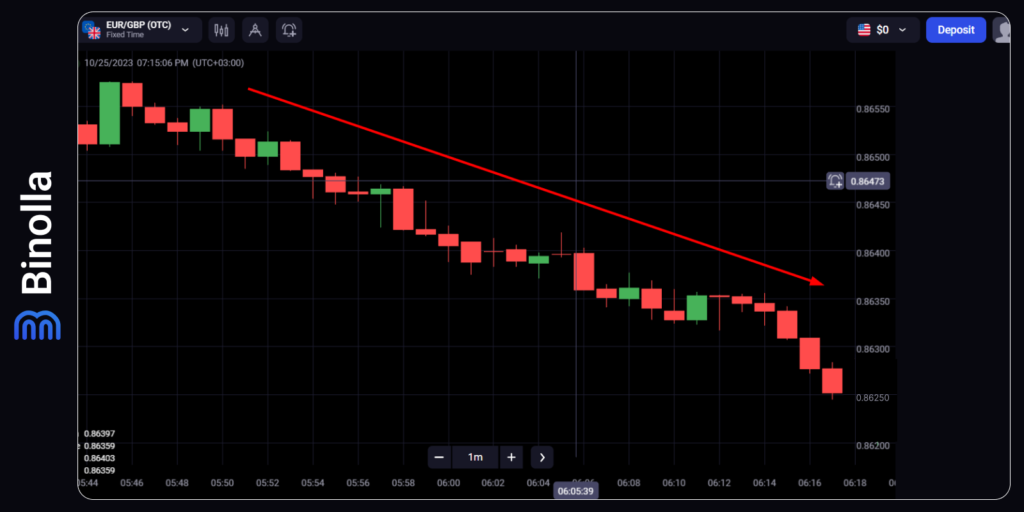
The downtrend, in turn, is the opposite situation when the price is decreasing. When you look at charts, you will see that the price is constantly going down, i.e., its highs and lows become lower.

There are also situations where there is no trend at all as the price moves sideways. The highs and the lows are aligned. For instance, you can draw a horizontal line through lows, which will highlight the support level.
Forex Trends for Digital Options Traders
Those who trade digital options are less interested in trends, especially major ones that can be found in longer timeframes. This is due to the fact that such traders buy short-term contracts, and they can find profits even in small price fluctuations.
If you are trading 5s scalping contracts, for example, you are going to profit from a minor price movement. Sometimes even one pip matters. To buy such contracts, you don’t need to define the direction of the price movement. You simply use a strategy that provides you with a reversal signal, even a tiny one or stick to the current price movement to squeeze some pips out of it.
When trading options with longer expiration, you can still do without establishing the current price movement direction, as you can rely on reversal signals regardless of their nature (trend reversal or a minor swing within a trend).
However, you can still spend some more time defining major price movements within your favorite timeframe to get better signals.

The example above shows a situation where you can buy a higher contract. If you define the price movement direction, you are going to trade along with the main trend, which provides you with more chances of being successful. One of the key things to take from here is that counter-trend swings are shorter and are not supported by major market volumes. Therefore, trading along with the current trend is better.
Major and Minor Trends
We have already determined that trends are of less importance for digital options traders. However, for FX and stock traders, they mean a lot, as most strategies are based on trends. When a professional trader hears that the trend is growing, they think about the major trend, which can be found in higher timeframes. However, depending on your trading style, you may also need to watch different segments of the same price tendency, which are known as “minor” trends.

The price movement that is illustrated in the image above seems to be integral and straightforward. However, if you go down through timeframes, you will see that it includes minor uptrend and downtrend segments.

While some of these counter-trend movements still look like corrections, others may look like downtrends within a general uptrend, and the deeper you delve, the more minor trends you will see. Therefore, you should always keep in mind that even if there is an uptrend on a monthly or weekly timeframe, the price may trade in a downtrend on an hourly or minute chart. This information is especially important for FX and stock traders who try to stick to the main price movements even if they buy or sell against the major trend.
How to Identify Forex Trend
Now that you know the basics of Forex trends and their importance, it is time to discover how to identify such price movement directions. There are plenty of ways to do it and most of them are very simple.
Identifying Forex Trends by Looking at Charts

The first and simplest way to identify trends is to simply look at them. If you see the price going up, you can assume that the uptrend is in place. When the price goes down, the downtrend is developing.
While being the easiest way to identify trends, this method has a lot of disadvantages. And first one is that you can’t see a clear picture of what is going on. Even if you see the current price movement, you can’t say for how long it will be relevant. Therefore, it is better to use other methods that will bring you a clearer picture.
Identifying Trends with Trendlines

One of the most reliable ways to identify a trend is to draw a trendline. To do it with Binolla, you should go to the tools section by clicking the button at the top of the platform, then choose Drawing and Trendline within this submenu.
After the line appears, you should use the three points on the chart. The first one will be the initiate trend point from where the movement starts. It has the lowest low. The second point is the first high, and the third one is the second low. Keep in mind that you may need to adjust your trendline over time.
After you complete all the above-mentioned, you will see a line that highlights the price direction. In our example, we have an uptrend. The price hits the trendline several times, which offers traders few possibilities to open trades.

The same is relevant for downtrends. You can apply a trendline by building it through the first two descending highs with one low between them. As you can see, the line goes further and the price hits it from time to time, providing you with some trading opportunities that we are going to consider in the paragraphs that follow.
How to Identify Forex Trends with Moving Averages

There is another method for traders to identify trends. They can use one of the trend indicators. The most popular one is a moving average, which, as it comes from its name, averages price fluctuations and highlights the price direction with a simple line.
Keep in mind that the default period of the trendline on the Binolla platform is 10. We have changed this parameter by increasing it to 50 in order to have a straight line. This may be a good solution, but in this case, the lag between the price and the indicator is higher.
In the example above, the price goes below the moving average, which means that the downtrend is developing. You can see that candlesticks reject the indicator several times, which confirms that the bears are dominating.
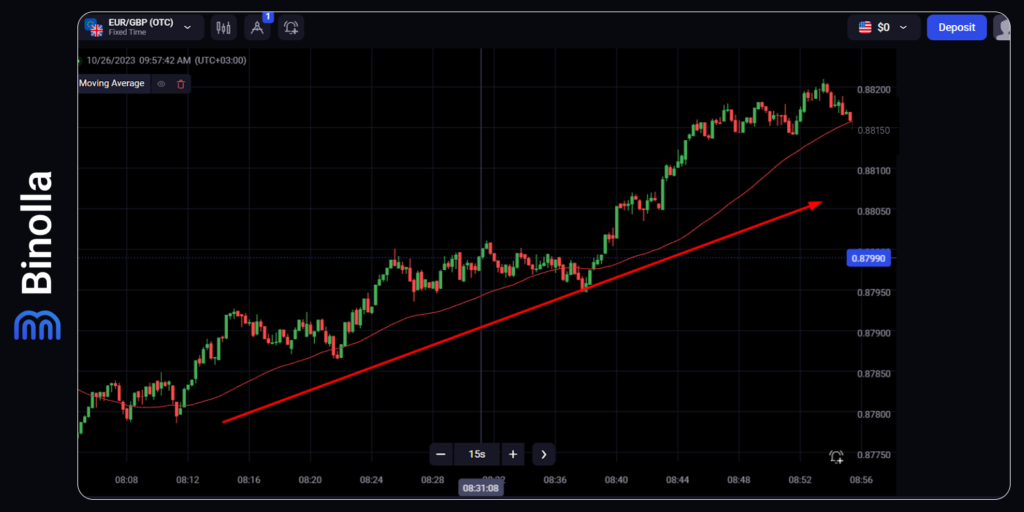
The moving average indicator is able to show both trends. This means that if the price movement direction is upward, you can also see it highlighted by the technical analysis tool. As you can see, the price stays above the indicator, which is one of the features of the uptrend.
Forex Trend Analysis and Strategies
Going further, you can use a lot of trend strategies to succeed. We have already mentioned that digital options traders are less dependent on price direction, but they can still look at major trends to be more sure when making decisions.
Trend Strategies with Trendlines

Trendlines that we have already mentioned in this article are good for defining trends. However, they can also be used to find entry points. The strategy here is very simple. You should wait for the price to test the trendline. If the price rejects it, you can buy an asset when trading FX or stocks, or simply buy a Higher digital option.
The idea behind this system is very straightforward. The price stays within the uptrend, and therefore, it is likely to continue its directional movement. The strategy is relevant until the trendline is broken by the price.
The Doncian Channels Trend Trading Strategy
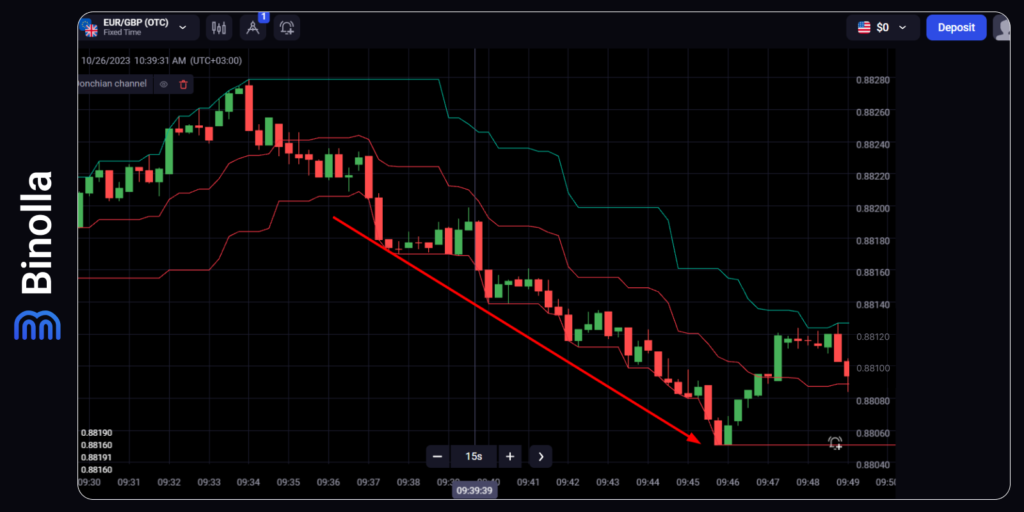
While not so popular, the Donchian Channel is among the most interesting technical indicators. When the price goes down along the lower line below the middle moving average, you can buy a Lower contract or sell a currency pair or a stock.
Keep in mind that for this particular strategy, the price should remain below the middle line. Once it makes a breakout, the system is no longer relevant as the trend changes.
Swing Strategies
Forex and stock traders can use various swing strategies to stick to a trend and add to their positions. This type of trend trading tactic involves buying after the end of downside corrections and selling once upward corrections are done.
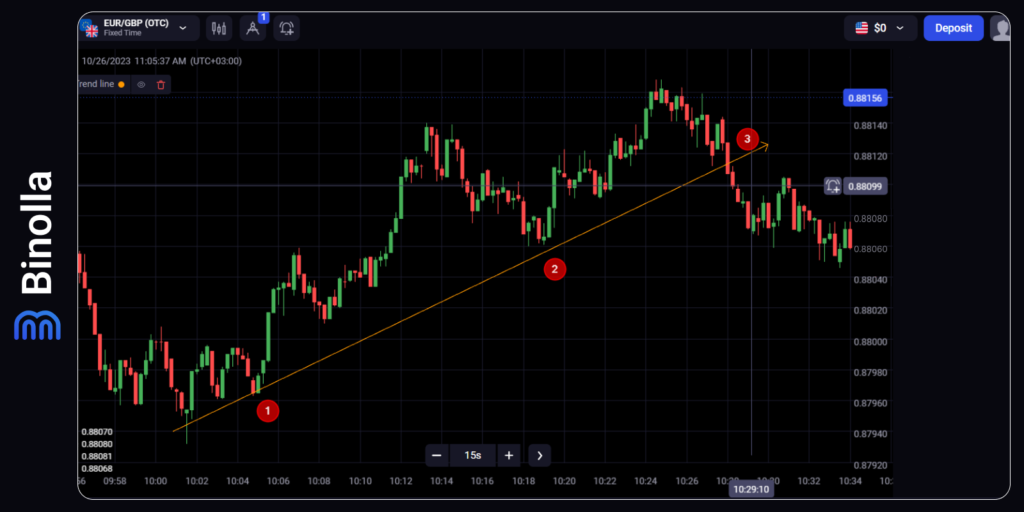
The simplest swing strategy involves using a trendline. Points 1 and 2 can be used by traders to add to their positions while the price follows the trend. This system allows you to both add trades and exit from the market.
In points 1 and 2, you can buy a currency pair or a stock. Therefore, your market presence will be extended by two additional positions. Holding them until the price finally breaks the trend line in the third point will allow you to accumulate higher profits.
Trend Strategy with MACD

The MACD indicator is a very popular technical analysis tool that allows you to find and follow major trend movements. It also provides you with the opportunity to join a trend at the moment of its inception. One of the most interesting ways to trade with this indicator is to sell a currency pair or a stock when the histogram goes below the 0 level and moving averages cross above the histogram as well as go downward. Digital options traders can also apply this method, by the way. They should buy a Lower contract when the signal comes.

The same can be applied to uptrends. When the histogram jumps above 0 and the moving averages cross and go upwards, you can buy a currency pair or a stock. Also, digital options traders can buy a Higher contract. To find an exit point, you simply need to wait until the MACD histogram falls below 0 again.
Trend Trading with Patterns
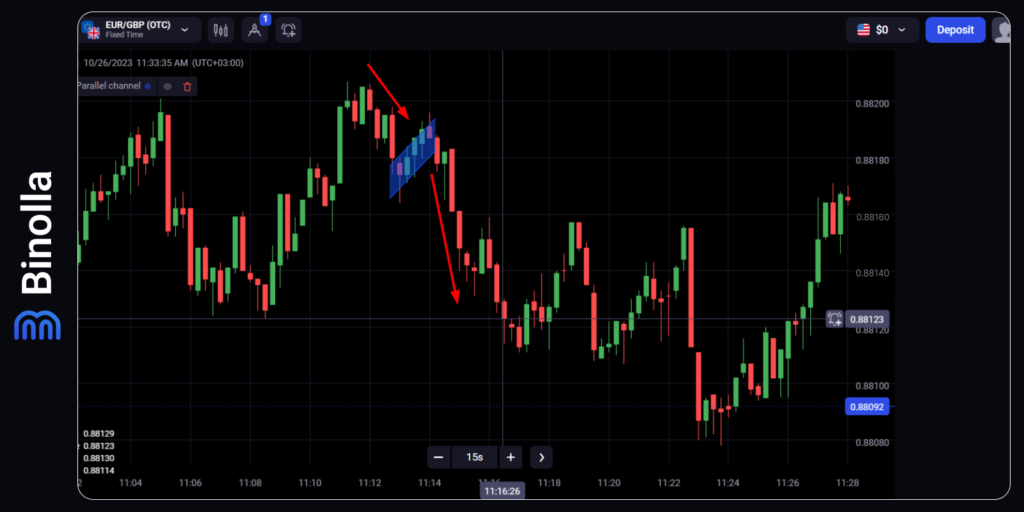
Some patterns can also be useful for traders to stick to the trend. In the example above, we have highlighted a flag pattern, which appears in the middle of the downtrend. Once you notice it, you can sell after the price breaks the lower border of the flag. For digital options traders, this is an opportunity to buy a Lower contract. Forex traders can enter along the trend or add to their existing positions.
Trend Trading Recommendations
Trend trading is a method that involves following the direction of the market and taking advantage of its momentum. Here are some recommendations for trend trading:
- Identify the trend. You can use various tools and indicators to determine the direction and strength of the market, such as moving averages, trend lines, chart patterns, etc.;
- Choose your entry and exit points. You can use signals such as breakouts, pullbacks, candlestick patterns, etc. to enter and exit the market in alignment with the trend;
- Manage your risk. You can use stop-loss orders, trailing stops, position sizing, etc. to protect your capital and lock in your profits;
- Be flexible and adaptable. You can use different time frames, markets, and instruments to find the best opportunities for trend trading. You can also adjust your strategy according to changing market conditions.
Trend Trading Pros and Cons
Some of the pros of trend trading are:
- Trend trading can be profitable in both rising and falling markets, as long as the trader follows the dominant trend;
- Trends can reduce the risk of entering at the wrong time or exiting too early, as the trader waits for clear signals and confirmation from the trend;
- This approach can simplify the decision-making process, as the trader only needs to focus on one direction and one timeframe;
- Trends allow traders to capture large price movements and generate consistent returns over time as they ride the trend until it reverses.
Some of the cons of trend trading are:
- Sometimes, It can be challenging to identify and define a trend, as different traders may have different criteria and perspectives on what constitutes a trend;
- False signals and whipsaws may waste your trend trading routine, as the market may experience temporary fluctuations or corrections that go against the trend;
- It can require patience and discipline, as the trader may have to endure periods of drawdowns or sideways movements before the trend resumes;
- It can incur higher transaction costs, as the trader may have to adjust their positions frequently to maintain their exposure to the trend.
FAQ

What is trend trading?
Trend trading is a trading strategy that involves following the direction of the market and taking advantage of its momentum. Trend traders use technical analysis tools such as moving averages, trend lines, and chart patterns to identify and follow trends.
What are the benefits of trend trading?
Trend trading can offer consistent and profitable results over time, as long as the trader can identify and stick to the trend. Trend trading can also reduce the emotional stress of trading, as the trader does not have to constantly monitor the market and make decisions based on short-term fluctuations.
What are the challenges of trend trading?
Trend trading can be challenging because it requires discipline, patience, and risk management. Trend traders have to deal with false signals, whipsaws, and market noise that can disrupt the trend. Trend traders also have to set appropriate stop-losses and take-profits to protect their positions and lock in their gains.
How can one improve their trend trading skills?
One can improve their trend trading skills by studying the market history, learning from successful trend traders, and practicing on a demo account. Traders can also use backtesting and forward-testing tools to evaluate their trend trading strategies and optimize their performance.







